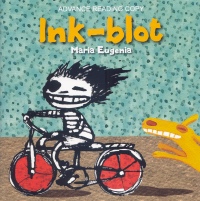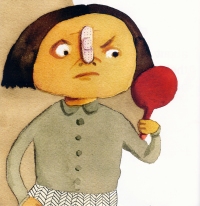| ________________
CM . . .
. Volume XX Number 2 . . .September 13, 2013
excerpt:
In Ink-blot, Maria Eugenia ambitiously tackles the topic of self-acceptance in young girls. The title character, Ink-blot, is a drawing, but Eugenia uses her to help girls learn to accept their bodies, flaws and all.
Throughout the book, Eugenia is very careful to represent a multicultural cast of girls; unfortunately, the thing that binds them is their unhappiness about how they look. Body acceptance has been a popular theme for children’s books, especially those aimed at girls. However, the more successful books move beyond a simple refutation of body image worries and examine underlying causes and beliefs. Ink-blot merely lists the concerns that girls have about their appearances. It is troubling that certain assumptions are made in the book: “Okay, we know that most girls think... they’re badly drawn” (pp. 3-6). Readers who are comfortable with their bodies may feel that, in order to fit in with “most girls”, they need to be ashamed of their bodies. It is then followed by several pages of girls looking displeased with their “problem” body parts. While it seems to be creating an environment in which the readers can empathize with the characters, the resulting conversation is likely to be one where readers pick apart their appearances rather than feel happy with who they are. The resolution, when it comes, is unsatisfying because the omniscient narrator just declares that their worries are “completely silly!” (p. 18). At this point in the plot, readers are reminded of Ink-blot and her poorly drawn self. Euguenia, although well meaning, in writing “Ink-blot thinks that what they say is completely silly. And -- SHE COULDN’T CARE LESS!” (pp. 23-4), may actually suggest to her readers that their opinions and beliefs about themselves are trivial. On first reading, the message seems to be that readers should not worry about what others say about them. However, in the context of the rest of the book, which covers concerns that girls have about their own bodies, it instead undermines readers’ confidence in their ability to judge what is and is not of concern. It applies a blanket statement of body acceptance without recognition of girls’ internal voices or concerns. Since their concerns about their appearances are silly, it implies that their internal value systems are not valued or respected by others. There are other ways to address body acceptance without damaging one’s self-esteem, but it requires a deeper exploration of causes and belief systems about what is considered attractive in a particular society. Ink-blot does not offer readers a response to their worries that is fulfilling and meaningful. This book is intended for ages 5-7, but the writing is too sparse and the story too underdeveloped for more sophisticated readers in that age range. Due to some awkward phrasing, the text is difficult to read aloud. Given the story’s brevity and surface examination of body acceptance, it would be tough to use Ink-blot as a stand alone book; however, Ink-blot might work as an introduction and bridge to more complex and deep works on the issue of body acceptance. Ink-blot is well-intended and has interesting visuals, but ultimately the book oversimplifies the many factors that play into body image and self-acceptance. Recommended. Sabrina Wong is a librarian at the University of Calgary in Calgary, AB.
To comment
on this title or this review, send mail to cm@umanitoba.ca.
Copyright © the Manitoba Library Association. Reproduction for personal
use is permitted only if this copyright notice is maintained. Any
other reproduction is prohibited without permission.
NEXT REVIEW |
TABLE OF CONTENTS FOR THIS ISSUE
- September 13, 2013.
AUTHORS |
TITLES |
MEDIA REVIEWS |
PROFILES |
BACK ISSUES |
SEARCH |
CMARCHIVE |
HOME |

 Eugenia, an award-winning illustrator, uses a diverse set of techniques from soft digitally-altered watercolour and harsher ink drawings to digital clip-art style pictures. While the characters are depicted in an eclectic assortment of media, Eugenia has given them all wonderfully expressive faces. She understands the importance of white space and the layering of different components to create a dynamic spread. Although text is sparse in her book, the illustrations reinforce and create deeper meaning. In the spread on pages 7-8, where the text simply states, “Some worry about their hair...”, Eugenia shows three girls of different ethnicities sharing similar looks of uneasiness. Worrying about their hair is transformed into a common concern that acts as a bridge rather than as a marker of difference.
Eugenia, an award-winning illustrator, uses a diverse set of techniques from soft digitally-altered watercolour and harsher ink drawings to digital clip-art style pictures. While the characters are depicted in an eclectic assortment of media, Eugenia has given them all wonderfully expressive faces. She understands the importance of white space and the layering of different components to create a dynamic spread. Although text is sparse in her book, the illustrations reinforce and create deeper meaning. In the spread on pages 7-8, where the text simply states, “Some worry about their hair...”, Eugenia shows three girls of different ethnicities sharing similar looks of uneasiness. Worrying about their hair is transformed into a common concern that acts as a bridge rather than as a marker of difference.